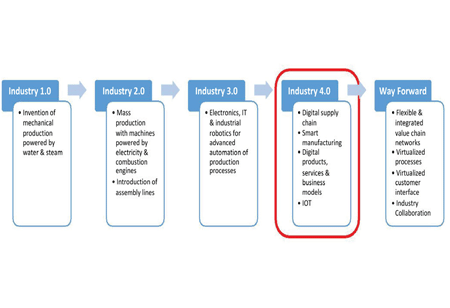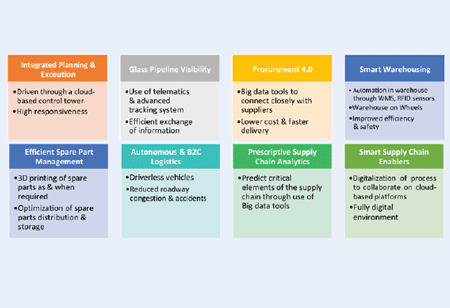
Industry 4.0 & Supply Chain Transformation


Jasjit Sethi, CEO, TCI Supply Chain Solutions
Disruptive innovations, powered by Industry 4.0 are currently changing the landscape of many industries and their business models. Because of the increasing digitalized processes and an exponential growth of sensible data, supply chains are also impacted by the fourth industrial revolution. The fourth industry revolution is marked with realtime exchanged data, automation, robotics, cloud, artificial intelligence (AI), connected devices and equipment(Internet of Things), and augmented reality to connect innovation, new technologies, and humans.
Similarly, in the field on logistics, the fourth industrial revolution coined as, Logistics 4.0 has recently emerged as a move to smart transportation and logistics, enhanced sales and operations planning(S&OP), and dynamic logistics network configuration.
Technology Revolution in the Supply Chain Industry
Behind the great potential of the digital supply chain(DSC) lies Industry 4.0, the fourth industrial revolution. A transformation in production & automation was brought on first by steam & water power (Industry 1.0), then by electrification (2.0), and more recently by the digital computer(3.0). Industry 4.0, digitization, is about companies orienting themselves to the customer

through e-Commerce, digital marketing, social media, and the customer experience. Ultimately, virtually every aspect of business will be transformed through the vertical integration of research & development, manufacturing, marketing & sales, and other internal operations, and new business models based on these advances. In effect, we are evolving towards a complete digital ecosystem. There has been more value & optimization in the supply chain, but also at the same time, the supply chain has turned out to be complex than earlier.
The traditional supply chain was simpler, but had less visibility between the levels involved, thus hindering meaningful collaboration of the supply chain. Communication was delayed as it was passed through each level in a hierarchy & hence resulted in lower level of responsiveness. But, with digitalization, the traditional supply chain has grown to be an integrated supply chain
ecosystem, with complete visibility & simultaneous communication across the whole supply chain. This integrated supply chain ecosystem is also characterized by high flexibility & responsiveness right from planning till execution level.

Supply Chain as the Epicenter of Digital Enterprise
Companies are moving towards a digital workplace, where there are applications of e-finance & e-HR, and complete reliance on digital knowledge sharing. Vertical integration, big data process optimization, augmented reality, and many more has set in forth in the engineering & manufacturing practices. Industry 4.0 has also marked its place in the business models of the companies via digitally enhanced products & services and automated solutions. Companies are orienting themselves to the customer through e-Commerce, digital marketing, social media, in a motive to maximize customer experience. Hence, virtually every aspect of business is being transformed through the vertical integration of research & development, manufacturing, marketing and sales, other internal operations, and new business models based on these advances. As supply chain management serves as the connecting nerves of all the business aspects, hence with digitalization of whole business processes, the digitalization of supply chain is a must.
Key Technology Requirements in Moving towards the Digital Ecosystem
Supply chain can be classified into few key elements- plan, source, make, deliver, return, and enable. Through technological innovation with Industry 4.0, these elements are rapidly being rekindled. Few key technological trends in the supply chain have been described as above:
Conclusions
Supply chains are extremely complex, and no company has yet succeeded in building a supply chain that’s truly digital. Indeed, many of the applications & trends required for moving towards a digital ecosystem are not yet widely used. But this will change radically over the next few years, with different industries implementing DSC at varying speeds. Companies that get there first will gain a difficult-to-challenge advantage in the race to Industry 4.0, and will be able to set, or influence technical standards for that particular industry. The advantage of adopting these technological trends will be by no means limited to the increased efficiencies of operations, but also set a competitive advantage amongst the counterparts. At the initial phase, undoubtedly many challenges in adopting to the technology trends will come-up, but ultimately we will be moving towards a fully digital ecosystem.

Supply Chain as the Epicenter of Digital Enterprise
Companies are moving towards a digital workplace, where there are applications of e-finance & e-HR, and complete reliance on digital knowledge sharing. Vertical integration, big data process optimization, augmented reality, and many more has set in forth in the engineering & manufacturing practices. Industry 4.0 has also marked its place in the business models of the companies via digitally enhanced products & services and automated solutions. Companies are orienting themselves to the customer through e-Commerce, digital marketing, social media, in a motive to maximize customer experience. Hence, virtually every aspect of business is being transformed through the vertical integration of research & development, manufacturing, marketing and sales, other internal operations, and new business models based on these advances. As supply chain management serves as the connecting nerves of all the business aspects, hence with digitalization of whole business processes, the digitalization of supply chain is a must.
Supply chain management serves as the connecting nerves of all the business aspects, hence with digitalization of whole business processes, the digitalization of supply chain is a must
Key Technology Requirements in Moving towards the Digital Ecosystem
Supply chain can be classified into few key elements- plan, source, make, deliver, return, and enable. Through technological innovation with Industry 4.0, these elements are rapidly being rekindled. Few key technological trends in the supply chain have been described as above:
Conclusions
Supply chains are extremely complex, and no company has yet succeeded in building a supply chain that’s truly digital. Indeed, many of the applications & trends required for moving towards a digital ecosystem are not yet widely used. But this will change radically over the next few years, with different industries implementing DSC at varying speeds. Companies that get there first will gain a difficult-to-challenge advantage in the race to Industry 4.0, and will be able to set, or influence technical standards for that particular industry. The advantage of adopting these technological trends will be by no means limited to the increased efficiencies of operations, but also set a competitive advantage amongst the counterparts. At the initial phase, undoubtedly many challenges in adopting to the technology trends will come-up, but ultimately we will be moving towards a fully digital ecosystem.